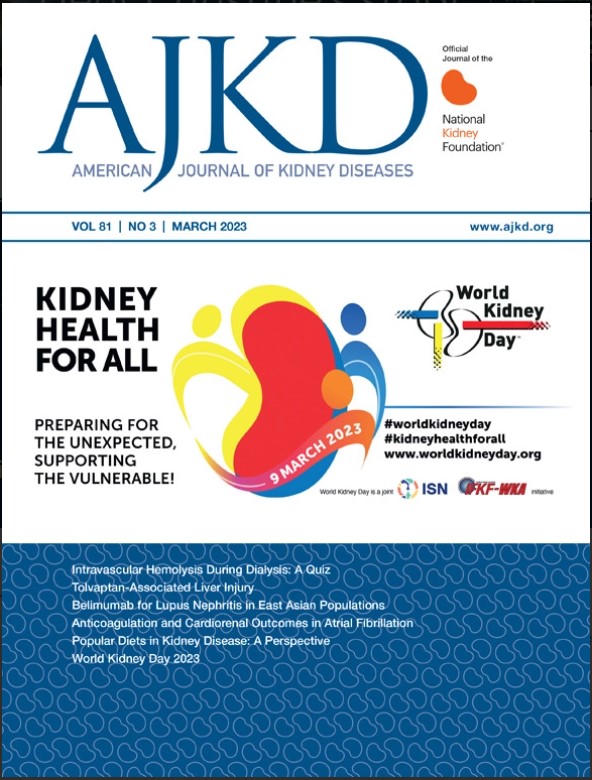Intensive Home Blood Pressure Lowering in Patients with Advanced CKD.
IF 9.4
1区 医学
Q1 UROLOGY & NEPHROLOGY
引用次数: 0
Abstract
RATIONALE & OBJECTIVE Optimal blood pressure (BP) targets in advanced CKD are controversial. More intensive BP lowering in the setting of advanced CKD is thought to be associated with risk of acute kidney injury, hyperkalemia, and ESKD. We aimed to conduct a pilot trial of intensive BP control to determine if lower SBP targets can be safely achieved for patients with CKD through titration of BP medications using in-home measured BP. STUDY DESIGN Non-blinded randomized controlled trial. SETTINGS & PARTICIPANTS 108 patients with advanced CKD (eGFR ≤30 mL/min/1.73 m2) and hypertension. INTERVENTIONS Participants were randomized either to a target home SBP goal of <120 mmHg (N=66) or a less intensive SBP goal (N=42). Antihypertensive medications were titrated to achieve the target home SBP range in the first 4 months of the study and maintained until the end of the study. Home BP was measured using a wireless Bluetooth-enabled monitor that transmitted readings to providers in real-time. OUTCOMES The primary efficacy outcome was the difference in achieved clinic SBP between the two study arms from months 4-12. Safety outcomes included hyperkalemia, a composite outcome of falls or syncope, and onset of need for dialysis or kidney transplantation. RESULTS The mean clinic SBP at month 12 was 124.7 mmHg in the intensive SBP group vs. 138.2 mmHg in the less intensive SBP group. Averaged over months 4-12, the achieved mean clinic SBP in the intensive SBP arm was 11.7 mmHg (95% CI 7.5 to 16 mmHg, p<0.001) lower than the mean SBP achieved in the less intensive SBP arm. Primary safety outcomes were not statistically significantly different between the two arms (all p>0.05). LIMITATIONS Small sample size which may limit our ability to detect clinically significant differences in rates of adverse outcomes; single-center design. CONCLUSIONS A clinic SBP goal of <120 mmHg is feasible to achieve with the help of real-time home BP monitoring and appears to be safe in this study population with advanced CKD. Larger trials to determine optimal BP targets in advanced CKD and the risks and benefits associated with more intensive BP control are warranted.晚期慢性肾脏病患者的家庭强化降压治疗。
原理与目的 晚期慢性肾脏病的最佳血压(BP)目标尚存在争议。在晚期 CKD 的情况下,更密集地降低血压被认为与急性肾损伤、高钾血症和 ESKD 的风险有关。我们旨在开展一项强化血压控制的试点试验,以确定是否可以通过使用居家测量血压滴定降压药物,安全地为 CKD 患者实现较低的 SBP 目标。局限性样本量较少,这可能会限制我们检测不良后果发生率方面具有临床意义差异的能力;单中心设计。结论在实时家庭血压监测的帮助下,实现<120 mmHg的门诊血压目标是可行的,而且在晚期CKD患者中似乎是安全的。有必要进行更大规模的试验,以确定晚期 CKD 的最佳血压目标以及更强化血压控制的相关风险和益处。
本文章由计算机程序翻译,如有差异,请以英文原文为准。
求助全文
约1分钟内获得全文
求助全文
来源期刊

American Journal of Kidney Diseases
医学-泌尿学与肾脏学
CiteScore
20.40
自引率
2.30%
发文量
732
审稿时长
3-8 weeks
期刊介绍:
The American Journal of Kidney Diseases (AJKD), the National Kidney Foundation's official journal, is globally recognized for its leadership in clinical nephrology content. Monthly, AJKD publishes original investigations on kidney diseases, hypertension, dialysis therapies, and kidney transplantation. Rigorous peer-review, statistical scrutiny, and a structured format characterize the publication process. Each issue includes case reports unveiling new diseases and potential therapeutic strategies.
 求助内容:
求助内容: 应助结果提醒方式:
应助结果提醒方式:


